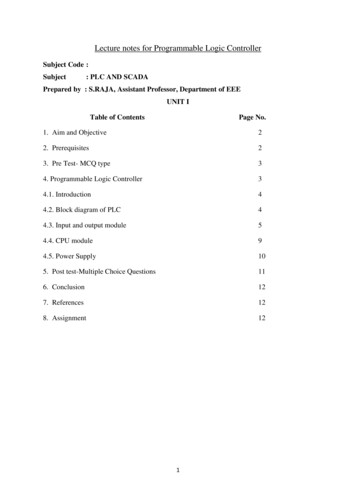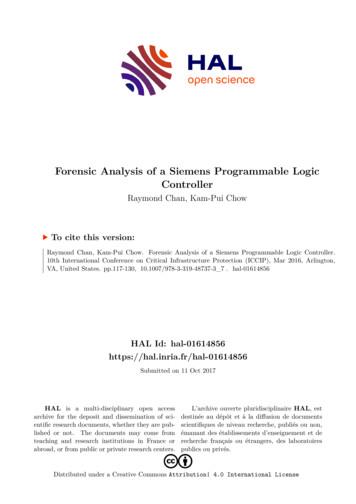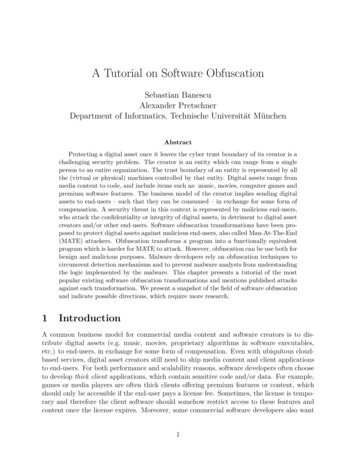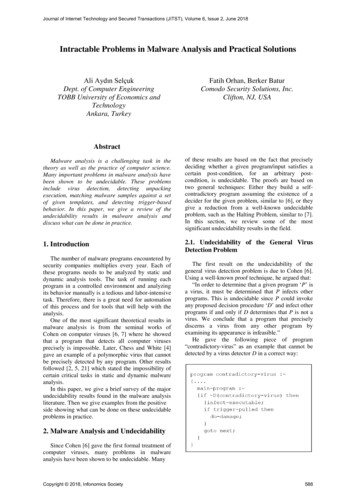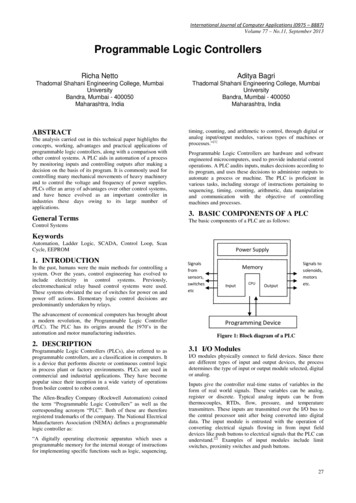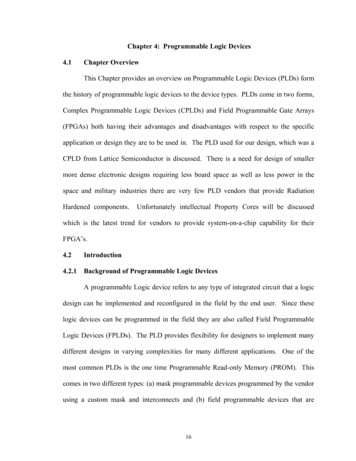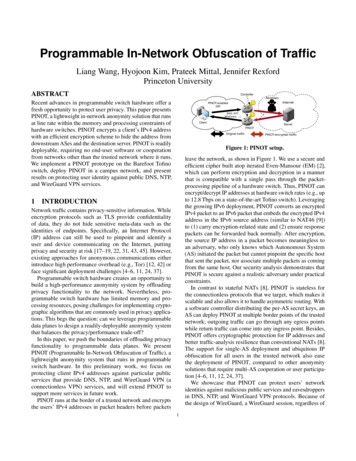
Transcription
Programmable In-Network Obfuscation of TrafficLiang Wang, Hyojoon Kim, Prateek Mittal, Jennifer RexfordPrinceton UniversityABSTRACTControllerAdversaryRecent advances in programmable switch hardware offer afresh opportunity to protect user privacy. This paper presentsPINOT, a lightweight in-network anonymity solution that runsat line rate within the memory and processing constraints ofhardware switches. PINOT encrypts a client’s IPv4 addresswith an efficient encryption scheme to hide the address fromdownstream ASes and the destination server. PINOT is readilydeployable, requiring no end-user software or cooperationfrom networks other than the trusted network where it runs.We implement a PINOT prototype on the Barefoot Tofinoswitch, deploy PINOT in a campus network, and presentresults on protecting user identity against public DNS, NTP,and WireGuard VPN services.1InternetPINOT-enabledISP(DNS, NTP,WireGuard, )ClientServerPINOTOriginal trafficPINOT-encrypted trafficFigure 1: PINOT setup.leave the network, as shown in Figure 1. We use a secure andefficient cipher built atop iterated Even-Mansour (EM) [2],which can perform encryption and decryption in a mannerthat is compatible with a single pass through the packetprocessing pipeline of a hardware switch. Thus, PINOT canencrypt/decrypt IP addresses at hardware switch rates (e.g., upto 12.8 Tbps on a state-of-the-art Tofino switch). Leveragingthe growing IPv6 deployment, PINOT converts an encryptedIPv4 packet to an IPv6 packet that embeds the encrypted IPv4address in the IPv6 source address (similar to NAT46 [9])to (1) carry encryption-related state and (2) ensure responsepackets can be forwarded back normally. After encryption,the source IP address in a packet becomes meaningless toan adversary, who only knows which Autonomous System(AS) initiated the packet but cannot pinpoint the specific hostthat sent the packet, nor associate multiple packets as comingfrom the same host. Our security analysis demonstrates thatPINOT is secure against a realistic adversary under practicalconstraints.In contrast to stateful NATs [8], PINOT is stateless forthe connectionless protocols that we target, which makes itscalable and also allows it to handle asymmetric routing. Witha software controller distributing the per-AS secret keys, anAS can deploy PINOT at multiple border points of the trustednetwork; outgoing traffic can go through any egress pointswhile return traffic can come into any ingress point. Besides,PINOT offers cryptographic protection for IP addresses andbetter traffic-analysis resilience than conventional NATs [8].The support for single-AS deployment and ubiquitous IPobfuscation for all users in the trusted network also easethe deployment of PINOT, compared to other anonymitysolutions that require multi-AS cooperation or user participation [4–6, 11, 12, 24, 37].We showcase that PINOT can protect users’ networkidentities against malicious public services and eavesdroppersin DNS, NTP, and WireGuard VPN protocols. Because ofthe design of WireGuard, a WireGuard session, regardless ofINTRODUCTIONNetwork traffic contains privacy-sensitive information. Whileencryption protocols such as TLS provide confidentialityof data, they do not hide sensitive meta-data such as theidentities of endpoints. Specifically, an Internet Protocol(IP) address can still be used to pinpoint and identify auser and device communicating on the Internet, puttingprivacy and security at risk [17–19, 22, 31, 43, 45]. However,existing approaches for anonymous communications eitherintroduce high performance overhead (e.g., Tor) [12, 42] orface significant deployment challenges [4–6, 11, 24, 37].Programmable switch hardware creates an opportunity tobuild a high-performance anonymity system by offloadingprivacy functionality to the network. Nevertheless, programmable switch hardware has limited memory and processing resources, posing challenges for implementing cryptographic algorithms that are commonly used in privacy applications. This begs the question: can we leverage programmabledata planes to design a readily-deployable anonymity systemthat balances the privacy/performance trade-off?In this paper, we push the boundaries of offloading privacyfunctionality to programmable data planes. We presentPINOT (Programmable In-Network Obfuscation of Traffic), alightweight anonymity system that runs in programmableswitch hardware. In this preliminary work, we focus onprotecting client IPv4 addresses against particular publicservices that provide DNS, NTP, and WireGuard VPN (aconnectionless VPN) services, and will extend PINOT tosupport more services in future work.PINOT runs at the border of a trusted network and encryptsthe users’ IPv4 addresses in packet headers before packets1
the protocols underneath, would not be disrupted by PINOTeven if every WireGuard packet has a different source IPaddress [15]. The combination of WireGuard and PINOTcan be a useful building block for bootstrapping advancedprivacy-enhancing techniques.We implement a prototype of PINOT on a Tofino switchand deploy it in a campus network to forward DNS, NTP,and WireGuard traffic. We show PINOT is feasible as itcan correctly encrypt, decrypt, and forward packets. Whileprevious works have implemented cryptographic algorithmson programming data planes using CPUs, SmartNICs, orNetFPGAs [20, 21, 39], to the best of our knowledge, weare the first to implement a working secure and efficientencryption scheme that runs at line rate within Tofino ASICs.of personalized ad content (i.e., IP targeting ads) [17].Besides, VPN services may unintentionally leak clients’IP information [34]. We focus on WireGuard, a UDPbased, connectionless VPN protocol being added to theLinux kernel [15]. WireGuard leverages a special mechanismto achieve good IP mobility: it assumes a peer’s publicIP address can change frequently, and maintains a peeraddress table to record the source IP address in the latestpacket received from the peer for future commutations. Thismechanism enables us to obfuscate peer (user) IP addressesin WireGuard traffic without disrupting connectivity.2Sender anonymity. With sender anonymity, an adversarycannot discover the identity (IP address) of the client (sender).We do not try to hide the server’s identity or the AutonomousSystem (AS) of the client.2.2PINOT PROBLEM DEFINITIONWe study how to design a readily-deployable, in-networkprivacy-enhancing system with minimal performance overhead. As the first step towards a comprehensive in-networkanonymity system, we consider a lightweight notion ofanonymity, in which the AS where PINOT is deployed istrusted and can observe both ends of a communication session.We only consider protecting the user’s IP address againstwidely-used public services that are running connectionlessprotocols, namely, DNS, NTP, and WireGuard. In this section,we elaborate on motivating use cases, design goals, threatmodel, and hardware resource constraints.2.1Design goalsMotivated by the above use cases, we seek to design a systemthat achieves the following privacy properties:Packet unlinkability. We define packet unlinkability forconnectionless protocols as: given a set of packets, the adversary cannot determine whether the packets are associatedwith the same client based on observed IP addresses. Thisproperty helps protect users against traffic-analysis attacksor user tracking. Associating packets to clients using non-IPinformation is beyond the scope of this paper.Additionally, we want to achieve two operational goals:Low deployment barriers. The solution should be readily deployable without modifications to existing Internetinfrastructure and protocols, or running special client-sidesoftware (i.e., no involvement of end-users).1 In addition,the solution should be able to provide ubiquitous privacyprotection for a set of users.Connectionless use casesThere are numerous privacy threats related to IP address leaks:DNS. DNS recursive resolvers are typically operated by theusers’ Internet service provider or third-party services (e.g.,Google and Cloudflare). Since DNS requests and responsesare in cleartext, DNS recursive resolvers or any on-patheavesdroppers can learn the IP address of a user and thedomain the user visited. Such information can be further usedfor inferring users’ browsing behaviors, fingerprinting andtracking users, or deanonymizing Tor users [19, 22, 45].Low performance overhead. We want our solution to process network traffic at hardware switch rates. Therefore, weneed to minimize the overhead introduced by cryptographicoperations, and keep as little per-packet/per-flow state aspossible (or, better yet, no state at all).NTP. NTP is widely used for synchronizing the clocks ofcomputer systems. A scanner may exploit NTP to discoveractive IPv6 and IPv4 hosts and conduct unauthorized scans.One such example is shodan.io [40], who contributes its ownNTP servers to a public NTP server pool, collects IP addressesof active NTP clients [18, 43], and performs vulnerabilityscans. The vulnerability information of hosts is publiclyavailable and can easily be gathered by attackers duringreconnaissance, posing security threats to the scanned hosts.2.3Threat model and assumptionsAs shown in Figure 1, we assume an unmodified clientcommunicates with a server through a trusted entity (anenterprise network or an ISP). The trusted entity and theserver should have both IPv4 and IPv6 connectivity. The goalof an adversary is to recover the actual client IP addresses ofnetwork traffic it observes, given the contents of the packetsthat it can see.We consider two types of attackers: passive and active. Thepassive adversary could be the remote server, or any networkVPN. There are privacy concerns with third-party VPNproviders. A recent report shows that 25 out of 123 VPNservices collect client IP addresses [31]. The IP informationcould be sold to advertising companies to facilitate delivering1 Client-sidesoftware could enhance privacy protection further, e.g., Torbrowser mitigates many application-layer privacy leaks.2
element between the trusted network and the server. Theadversary may be an AS; it could also be any intermediatenetwork point such as an Internet exchange point (IXP) oreven simply a link. An active adversary may control a fewhosts in the trusted network, and is able to send packets witharbitrary spoofed source IP addresses. We assume, however,that an active adversary cannot observe other users’ traffic inthe trusted network.Finally, we do not yet consider implementation-specificattacks, such as bugs in the implementation and bias in therandom number generators offered by hardware switches.2.4complex cryptographic computations such as hashing in thedata plane. With careful code optimization (e.g., rearrangingactions using P4 compiler macros to maximize the numberof parallel actions in each stage), 2EM can encrypt a packetin a single pass through the packet processing pipeline, yetis secure against a computationally bounded adversary inpractice.Our cipher encrypts a 𝑛-bit message 𝑀 by computing:𝐸 (𝑀) 𝑃 2 (𝑃 1 (𝑀 𝑘 0 ) 𝑘 1 ) 𝑘 2(1)where 𝑘 0, 𝑘 1 , and 𝑘 2 are n-bit independent encryption keysto thwart attacks that exploit key relation, and 𝑃1 and 𝑃2 areindependent permutations over 𝑛-bit strings, which can be implemented as substitution-permutation networks (SPN) [44].This construction has been proven to be secure up to2𝑛2 3 queries under adaptive chosen-plaintext and ciphertextadversaries [7, 26]. For encrypting 32-bit IPv4 addresses(𝑛 32), 2EM is only secure against 2.6 million queries,i.e., an adversary can recover keys or plaintexts with highprobability after knowing 2.6 M plaintext-ciphertext pairsusing efficient attacks [7, 30]. To improve the security ofPINOT, we adopt two approaches: Random padding to increase message size: We appenda 𝑙-bit random string to an IP address to extend the lengthof encryption input. The use of random padding improvesthe security of the encryption as 𝑛 becomes larger (𝑙 32).For 𝑙 32, our cipher is secure against about 7 trillionqueries. Random padding also makes the encryption nondeterministic, i.e., encrypting a given IP addresses multipletimes will produce different ciphertexts. This is desirable forachieving packet unlinkability. Key rotation to limit the number of encryptions undergiven keys: We update the key set (i.e., the three encryptionkeys) being used for encryption every 𝑡 seconds. Keyrotation limits the number of plaintext-ciphertext pairs anadversary can collect for given keys to reduce the attacksuccess probability, and minimizes the damage caused bycompromised encryption keys, as keys expire after at most𝑡 seconds.2 One potential issue caused by key rotation isinconsistent keys during encryption and decryption, i.e., thekey set may be updated when the packets from the serverare still in transit. To address this issue, we maintain threeversions of key sets, and rotate the key sets using the algorithmproposed in SPINE [11].A realistic adversary can only perform a reasonable amountof computation (i.e., computationally bounded) under limitedmemory resources. Given that the adversary might not be ableto send more than 1 trillion packets per second (approximately2.4 Pbps even if assuming the average IPv4 packet size is 300bytes [3]), the best known practical attacks against 2EM,which are chosen-plaintext attacks, require more than 289 bitsof memory for 𝑛 64 [13]. This is infeasible in practice.Hardware resource constraintsHigh-speed programmable switches can facilitate achieving the performance goal in §2.2. Programmable switchesdeployed at the border of the trusted network can processterabytes of traffic per second. Nevertheless, to build a systemwith the desired privacy properties, we need to work carefullywithin the hardware resource constraints.In a programmable switch, the packet-processing pipelineis divided into multiple stages. Each stage only allows alimited number of table lookups, and mathematical andlogical operations. A program running in the data planecan process traffic at line rate only if it can “fit” into theswitch ASIC—that is, if the program only requires thepacket to go through the pipeline once. Given the limitedstages in commodity programmable switches, fitting standardcryptographic algorithms into the switch, if possible, isextremely challenging (see §6 for more discussions).3PINOT DESIGNPINOT consists of a software controller for key management,and a data-plane program that performs IP address encryption/decryption at hardware switch rates using a lightweightyet secure cipher [2]. We use the IPv6 address encodingtechnique to avoid maintaining any per-flow or per-packetstate, similar to NAT46 [9]. With the controller distributingthe per-network encryption keys, PINOT can be deployed atmultiple border points of the trusted network and naturallyhandles asymmetric routing. Next, we discuss the encryptionscheme and IPv6 encoding.3.1Efficient encryption in the data planeStandard encryption algorithms such as AES are too complexto implement in a single pass through the switch ASIC.Performing multiple passes over the packets would causesignificant performance degradation, making line-rate encryption infeasible. Therefore, we look for a lightweightand secure cipher that can fit into switch ASICs. Afterexploring various options, we found that the two-round EvenMansour (2EM) scheme [2] satisfies our requirements. 2EMcan be implemented using table lookups and XORs, avoiding2 We3can also rotate the permutations.
In addition, generating a large volume of traffic from a fewhosts, if possible, can easily be flagged as DDoS attacks.3 SeeAppendix §A.1 for a detailed security analysis.2 ,3,045'()%6'7&& "##!40&/8')4&&,03EncryptionKeys9":';" '." #,/0'13.2Translation from IPv4 to IPv6IPv6AddressEncrypting a 32-bit IPv4 address will produce a ciphertextof 32 𝑙 bits (𝑙 is the length of the random padding), whichcannot be used as a valid IPv4 address for routing. The wholeciphertext also needs to be stored somewhere for decryption.To ensure return traffic can be correctly routed back based onthe encrypted IP addresses and to avoid maintaining any state,we transform an IPv4 packet into an IPv6 packet when thepacket leaves the trusted network. The IPv6 packet encodesthe encrypted IPv4 address in its IPv6 source address field,as shown in Figure 2. The highest 𝑑 bits of a transformedIPv6 source address are the IPv6 network prefix reservedby the trusted network, the lowest 32 𝑙 bits contain theencrypted IPv4 source address, and the remaining bits areused for storing encryption metadata such as the key setversion number. The values in the IPv4 header fields thathave corresponding IPv6 header fields are preserved.The IPv4 destination addresses are replaced with theirIPv6 counterparts. Recall that we only consider services withboth IPv4 and IPv6 addresses. Therefore, we can performDNS lookups in advance to get the IPv4 and IPv6 addressesof public servers of interest from their DNS A and AAAArecords, respectively, and store the IPv4/IPv6 address pairs ina lookup table for later use.We use the key version number in the IPv6 destinationaddress of a return (IPv6) packet to locate the key set fordecryption. The return packet is converted back to an IPv4packet and forwarded based on the decrypted address.3.3!"#" %"&'()%*') " ,-." #,/0'1 0 :? "&'()%6'7&& "##Figure 2: PINOT IPv6 source address encoding.the destinations or any other AS (other than the trusted AS),making it less prone to human errors and issues caused byextra latency (e.g., inaccurate time synchronization in NTP).4IMPLEMENTATIONPINOT consists of a software controller for key distributionand rotation, and a P4 data-plane program for encryption.The controller, which can run on a dedicated host or in thecontrol plane of a programmable switch, generates three 64bit encryption keys using the Python urandom function. Ituses grpc to communicate with the data plane to update thekeys and the key version number. In our evaluation, the keysare updated every five seconds.The two-bit version number is stored along with theport forwarding (i.e., switch ingress port to egress port)information in a forwarding table. For IPv6/IPv4 packettransformation, PINOT also maintains two address mappingtables (IP4to6 and IP6to4) that store the corresponding IPv6address of an IPv4 address, and vice versa, for the servers.PINOT generates random paddings via the Randomexternal function in the Tofino switch, and uses substitutionpermutation networks for permutation [44]. To permute a64-bit input, PINOT first performs substitution using 8-bitsubstitution boxes (S-boxes) to substitute every byte of theinput with another byte, and then applies a 64-bit straightpermutation box (P-box) to shuffle the bits of the S-box output.We currently use the static S-box in the AES standard andrandomly shuffle the bits in the P-box; we plan to generate Sboxes and P-boxes dynamically and update them periodicallyin the future.We implement two different PINOT prototypes: a 56-bitversion and a 64-bit version that use 24-bit and 32-bit randompaddings (i.e., 𝑙 24 and 𝑙 32), respectively. We use the56-bit version for the real-world deployment because we havea /64 IPv6 network allocated; with the 64-bit version, thereis no space left in an IPv6 address for the two-bit versionnumber. Figure 3 shows an example of IPv4 source addressencryption in the 56-bit PINOT. Even with the 64-bit PINOT,the S-box or inverse S-box tables only take up about 16 KBof memory, and the extra memory used for storing encryptionkeys and P-boxes are negligible. Such low overhead allowsPINOT to store additional encryption keys to encrypt morefields in the packet header. See Appendix §A.2.PINOT in the wildPINOT can improve user privacy for DNS, NTP, and WireGuard VPN services. PINOT moves trust from third-partyservers to the trusted network so that no party outside thetrusted network can see the real originating IP address ofa packet. Unlike NAT that assigns a user the same IP fora certain time period, PINOT assigns a random IP to everypacket, which is more effective at defeating user trackingbased on traffic patterns [22]. In addition, PINOT makesunsolicited scanning harder, as the mapping between theIP address and end-user device changes frequently. Finally,PINOT can perform IP address obfuscation at line rate for allusers in the trusted network without cooperation from users,3 Infact, the adversary cannot perform the best known attacks in a majorityof networks because of a lack of support for address spoofing (i.e., choosingplaintexts), according to the Spoofer project [27]. Adversaries are also limitedin terms of performing chosen-ciphertext attacks because they cannot see thedecrypted addresses: PINOT may forward a tampered packet based on thedecrypted address, or may drop the packet because it does not recognize thedecrypted address.4
Permutation (run two rounds)Port forwardingIPv4 pakcet96.(:; ; 8-bit S-BoxEncryption keys()* ,456456"&""''" 758911123332.2''&'-9,(:; ;/ / / /IP4to624-bitrandompadding()()"#" "#" ''"#-."#-.(:?0' ' / / / / !!////''C P2(P1(MIPv6 pakcetStraightP-BoxOutput: CDIffusion Layer:!shuffle bits96.(:; ; 5!! A".!/@3"!%3%3!%3%3-9,(:; !////Input: M IP PaddingEncryption:(:?@* ,* ,"#%&"#%&''"#/0"#/0K0)K1)IPv6 address encodingK2E5,FG6H;I65 J#; 456C0@DC&DK1)-GLCMDBC%0DFigure 3: IPv4 source address encryption in 56-bit PINOT.AWSIP4to6 and IP6to4 tables. We omit the evaluation results forNTP due to space considerations; note that the case is similarto DNS as both are single-packet protocols.WireGuardEC2 ServerTrusted NetworkWeb servicesDNSNTPWireGuard VPNIPv4PINOTEnd-hostLocal testbed: For the performance evaluation (Section 5.2),we set up a WireGuard tunnel in a local network. This is tominimize the effect of network conditions on throughput. Thetwo machines (Intel Xeon 2.2GHz CPU, 96 GB Memory)running WireGuard are connected to a Tofino Edge-CoreWedge 100BF-32X switch using 40GbE links. One machineis used as the client and the other one serves as the server.InternetIPv6IPv6GatewayDNS, NTPpublic serversFigure 4: PINOT deployment setup.5DEPLOYMENT AND EVALUATION5.1Wide-area tesbed: Figure 4 shows the PINOT deploymentin our network that connects to the wider Internet. The endhost IPv4 client device is a Linux server with two Intel XeonE5530 2.4GHz CPUs and 16GB of memory. The PINOTswitch sits between our end-host device and the trustednetwork’s border gateway. The switch is a Wedge 100BF32X switch with a Tofino programmable chip [29], and loadsthe PINOT P4 16 program. The switch acts as the IPv4gateway for the client. On the IPv6 side, our network’s bordergateway allocates a /64 IPv6 subnet to the PINOT switch;PINOT selects IPv6 addresses in this subnet that are used bythe IPv4 client when communicating with the Internet.The client’s DNS, NTP, and WireGuard traffic traverse thePINOT switch and the IPv6 border gateway to reach publicservers on the Internet. The PINOT switch automaticallytranslates a target server address to an IPv6 equivalent andvice versa for the response using pre-installed rules. Forthe WireGuard VPN experiment, we set up a WireGuardforwarding server on an AWS EC2 t2.micro instance. Ourclient’s WireGuard traffic traverses this server to reach webservices on the Internet.We test PINOT on DNS, NTP, and WireGuard traffic in ourevaluation. From the lists of 11,884 public DNS resolvers [35]and 223 NTP servers [28], we found 374 DNS resolvers and145 NTP servers that have both IPv4 and IPV6 addressesthus can answer IPv4 or IPv6 queries correctly. The IPv4/v6address pairs of these servers are stored in the PINOT switch’sFeasibilityWe evaluate if PINOT correctly encrypts, decrypts, andforwards DNS and WireGuard traffic.DNS. We use dig to send DNS queries for A records of tenunique domains randomly selected from the top 1 milliondomains to each resolver (totalling 3,740 queries), usingIPv4 and IPv6 networks. There are 3,387 consistent queries,i.e., returning the exact same A records in both settings;the inconsistent responses are caused by either DNS loadbalancing or resolver-side errors (misconfiguration, etc.). Wereplay the consistent queries with PINOT running and findall returned A records are consistent with the results that useIPv4 or IPv6 networks.WireGuard. We download 100 randomly selected files withvarying sizes (1 KB to 10 GB) from two websites [32, 41]. Allfiles download successfully through WireGuard and PINOT,and the SHA1 hash of every file matches that of equivalentdownloads directly using the IPv4 network.Overall, we conclude that per-packet encryption does notaffect the normal use of DNS and WireGuard.5.2PerformanceThough encryption and decryption can be performed at switchhardware rates (e.g., 3.2 Tb/s on our switch), there are twopotential sources of overhead:Latency introduced by IPv6 routing. The routing pathstaken by IPv6 packets and IPv4 packets could be different,5
Throughtput (Gbits/s)privacy applications to data planes. Previous works mostlyfocus on using switch CPUs, SmartNICs, or NetFPGAs toimplement cryptographic algorithms, but these approachesmay have performance, scalability, or compatibility issues [20,21, 39]. Very few studies have examined using switch ASICsfor cryptographic operations. SPINE implements a prototypeof SipHash for the BMv2 software model [11]. However,unlike in software, SPINE likely needs at least three passes ofthe packet on a hardware switch due to resource constraints,degrading the throughput by a factor of three. Similarly,P4-AES [1] requires at least two more passes of a packeton hardware switches. In contrast to SPINE and P4-AES,PINOT is able to fit into switch ASICs and encrypt source IPaddresses using a single pass of the packet processing pipelineon commercial off-the-shelf programmable switches.1086420TNA-5s-3s-1s-ppOT NOT NOT NOTNPIPIPIPIFigure 5: WireGuard throughput tests.affecting latency. We test 1,000 DNS queries and examine thequery time. Though using IPv6 may add up to 30 ms of delayin a query, PINOT does not introduce additional latency in97% of the cases.Hiding user IP addresses. Network-layer anonymity systems, such as LAP [24], Dovetail [37], HORNET [4], PHI [6],and TARANET [5], typically require multiple ASes along anend-to-end path to cooperate in the protocol and end-users torun specialized software. The involvement of end-users notonly further raises deployment barriers, but also introduceshuman errors [33] that cause privacy failures. None of thesystems were implemented on programmable hardware.Address Hiding Protocol (AHP) [36] and SPINE [11] canconceal users’ IP addresses without user participation. InAHP, a trusted network assigns a random IP address to a userfrom its own IPv4 address space, which poses security issuesfor small networks. Besides, AHP does not provide packetunlinkability. SPINE encrypts the IP address in every packetusing a programmable switch, but requires an additionaltrusted network to decrypt every packet.For DNS, DNS-over-HTTPS (DoH), DNS-over-TLS (DoT),DNSCrypt [14, 23, 25], or VPNs can protect users’ IP addresses. However, they put trust in third-party servers, whichcould become a single point of privacy failure. ObliviousDNS [38] hides IP addresses from third-party resolvers, butrequires modifications to clients and infrastructure. In contrastto known anonymity solutions, PINOT does not requirecooperation from end-users nor third-party services.WireGuard throughput degradation caused by addresstable update. WireGuard may update its peer address tablemore frequently to keep track of the ever-changing peer IPaddresses, which could affect its throughput. To minimize theeffect of other network conditions, we use the local testbeddescribed earlier in this section. We conduct throughput testswith the switch running PINOT that performs per-packetencryption (refer to this setting as PINOT-pp), and comparethe results to two baseline settings: (1) NAT: The switch actsas an NAT46 and simply converts IPv4 addresses to fixedIPv6 addresses. (2) PINOT-𝑡: The switch runs a modifiedversion of PINOT that uses the same padding for 𝑡 seconds.All the packets sent from the same client during that 𝑡 secondswill have the same encrypted source address.We run iperf TCP throughput tests (without optimization)for 300 seconds and collect the throughput reported by iperfevery second. As shown in Figure 5, the throughput decreasesas the address table update frequency increases. The averagethroughput drops from 8.3 Gbps (without address tableupdate) to 6.7 Gbps (with per-packet address table update).The performance bottleneck is the server’s CPU rather thanPINOT.4 If sender anonymity is the priority concern, one maylessen this degradation by using fixed random padding for abatch of packets, as in PINOT-5𝑠. In fact, WireGuard includespublic peer identity information that can be used to associatepackets to WireGuard sessions in packet payloads. Futurework on improving WireGuard against traffic analysis attacksmay consider mitigating application layer leaks with QUIC’spayload encryption mechanism.67RELATED WORKCryptographic algorithms in programmable data planes.The ability to support cryptographic algorithms in programmable hardware is important for offloading security and4 iperfCONCLUSIONPINOT is a lightweight in-network anonymity solution thathides users’ IP addresses from downstream ASes and destination servers. Utilizing an efficient and secure encryptionscheme, PINOT can encrypt IP addresses at hardware switchrates. In contrast to known anonymity solutions, PINOThas a low barrier to deployment, because it requires nocooperation from end-users or any ASes other than the trustednetwork where it is deployed. We implemented and deployeda prototype of PINOT, and demonstrated PINOT is feasiblefor improving user privacy in DNS, NTP, and WireGuardVPN protocols.CPU utilization is
computer systems. A scanner may exploit NTP to discover active IPv6 and IPv4 hosts and conduct unauthorized scans. One such example is shodan.io[40], who contributes its own NTP servers to a public NTP server pool, collects IP addresses of active NTP clients [18, 43], and performs vulnerability scans. The vulnerability information of hosts is .
